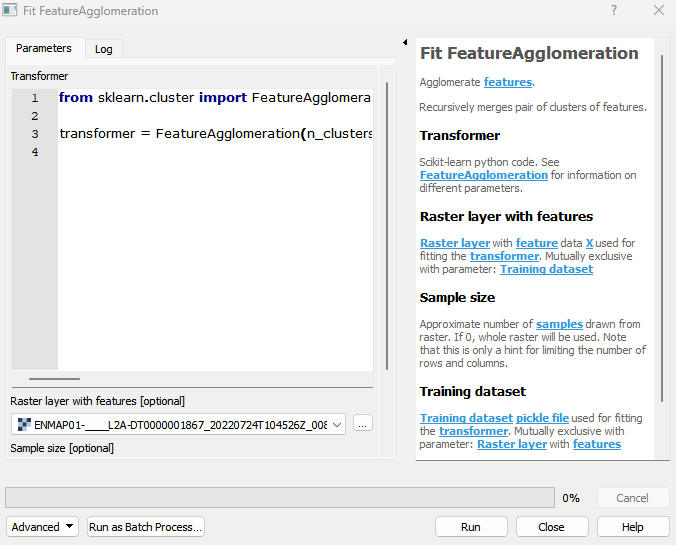Fit FeatureAgglomeration
Agglomerate features. Recursively merges pair of clusters of features.
Feature agglomeration groups similar features in a dataset to reduce dimensionality while preserving the most important information. This technique is particularly useful when dealing with high-dimensional data, as it can help reduce the computational complexity of subsequent analysis, eliminate noise, and potentially improve model performance.
Usage:
Start the algorithm from the Processing Toolbox panel.
Select a raster layer to process and click run.

Parameters
- Transformer [string]
Scikit-learn python code. See FeatureAgglomeration for information on different parameters.
Default:
from sklearn.cluster import FeatureAgglomeration transformer = FeatureAgglomeration(n_clusters=3)
- Raster layer with features [raster]
Raster layer with feature data X used for fitting the transformer. Mutually exclusive with parameter: Training dataset
- Sample size [number]
Approximate number of samples drawn from raster. If 0, whole raster will be used. Note that this is only a hint for limiting the number of rows and columns.
Default: 1000
- Training dataset [file]
Training dataset pickle file used for fitting the transformer. Mutually exclusive with parameter: Raster layer with features
Outputs
- Output transformer [fileDestination]
Pickle file destination.
Command-line usage
>qgis_process help enmapbox:FitFeatureagglomeration:
----------------
Arguments
----------------
transformer: Transformer
Default value: from sklearn.cluster import FeatureAgglomeration
transformer = FeatureAgglomeration(n_clusters=3)
Argument type: string
Acceptable values:
- String value
- field:FIELD_NAME to use a data defined value taken from the FIELD_NAME field
- expression:SOME EXPRESSION to use a data defined value calculated using a custom QGIS expression
featureRaster: Raster layer with features (optional)
Argument type: raster
Acceptable values:
- Path to a raster layer
sampleSize: Sample size (optional)
Default value: 1000
Argument type: number
Acceptable values:
- A numeric value
- field:FIELD_NAME to use a data defined value taken from the FIELD_NAME field
- expression:SOME EXPRESSION to use a data defined value calculated using a custom QGIS expression
dataset: Training dataset (optional)
Argument type: file
Acceptable values:
- Path to a file
outputTransformer: Output transformer
Argument type: fileDestination
Acceptable values:
- Path for new file
----------------
Outputs
----------------
outputTransformer: <outputFile>
Output transformer